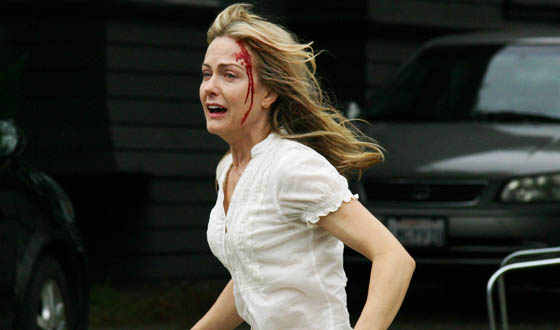When I’m really in the writing zone, in the midst of a scene, I’ve been known to leap up from the computer and begin pacing the floor, unaware of my surroundings, muttering dialog to myself. I imagine that to an observer I look like a hands-free cell-phone user (or someone who is off her meds). Except there’s not a person on the other end - there’s another world.
I sometimes have to figure out how I’m going to pull off the particular scene I have in mind. I know what I would like the reader to see in her head, what emotions or feelings I’d like to convey, but what is the most effective way to paint that picture, to evoke those feelings? If I write the scene in two or three different ways, I’ll often be able to come up with the right combination of images, but occasionally, I’ll realize that I don’t quite have it. What I need is more suspense!That’s when I go hunting. If I need more suspense, I pick out several works - literature or movies - that made me tense, and try to pick apart how it was done.
I’m always looking for effective ways to build tension. In the course of writing several books, I’ve seen and read all the classic suspense-building techniques in action, and keep a list of examples, not only to remind myself, but to use as a teaching tool as well. No matter what genre of book or story you are writing, a sense of suspense – anticipation – is necessary. Will the guy get the girl? Will the thieves pull off the heist? Will the astronaut evade the alien? Will the sheriff outdraw the outlaw? Will the ill child live? We readers want to know how it all turns out! And we authors want you to keep reading.A refresher on suspense-building never goes amiss, Dear Reader. Here are a few popular techniques I've garnered over the years.
The Ticking Clock: Our hero must accomplish something before a horrible thing happens. Diffuse the bomb before it goes off in two minutes! Find out who really did it before the wrong man is hanged! Great example, the movie D.O.A. (the 1950 original with Edmond O’Brien is better than the 1988 Dennis Quaid version).Drag Out the Action: Seems counterintuitive, doesn’t it? But if you just know the trap is going to spring, and it doesn’t... doesn’t...doesn’t... The anticipation is killing me! The trick here is timing. You have to know when enough is enough. Great example, Lee Child’s Bad Luck and Trouble.
Add More Peril: Our heroine is running through the jungle and the Columbian drug suppliers are right behind her, brandishing their machetes. She crashes through the brush, and finds herself on the edge of a cliff! There is a river at the bottom of the gorge, so she takes a leap, just feeling the breeze as a blade slashes over her head. She falls 75 feet into the river and realizes it’s infested with piranhas! She swims like the dickens, piranhas nipping at her heels, and as she nears the shore, 40 tribesmen with poisoned dart blowguns step out from the trees... No matter how bad the situation is, it can always be worse. Great examples, any of the Die Hard movies. I Know Something You Don’t Know: The author has told us the villain is hiding under the stairs, but the hero has no idea as he walks down into the dark basement. The author gives us a piece of crucial information that the characters don’t have. Great example, Louise Penny’s A Fatal Grace. The Cliffhanger: Remember the villain under the stairs? He leaps out! He grabs the hero around the neck! He pulls a knife! Meanwhile, back at the ranch... The reason the reader doesn't throw the book against the wall in frustration is because he wants to know what's been going on back at the ranch, too. Great example, Hour of the Hunter by J.A. Jance. My Hands Are Tied: Our hero can see disaster about to happen, but is powerless to stop it. Greatest example of all time, Alfred Hitchcock’s movie Rear Window. One Step Forward, Two Steps Back: Our sleuth spends weeks investigating Laura’s murder. He cannot discover a single clue to her death. Everyone loved her! She was wonderful and squeaky clean. He’s baffled, and sits in her apartment long into the night, pondering. One midnight, the front door opens, and... it’s Laura! She’s alive! Then who is the woman who was found lying on the floor of Laura’s apartment, wearing her clothes, shot in the face with a shotgun? And where has Laura been all this time? Ultimate example, the 1944 movie Laura.And one of my favorites:
Foreshadowing: This takes some skill to pull off well. The author gives us a hint that eventually something bad is going to happen, and the reader spends 300 pages in tingling anticipation She has that sense of inevitability. You say your hero is afraid of water - the reader just knows that fear is going to figure in to the climax. We knew it would come to this. If the author has set it up well, there are even a couple of false payoffs, leaving us still waiting with bated breath for it to happen. Excellent example, Robert McCammon’s Queen of Bedlam. What a set up!










No comments:
Post a Comment